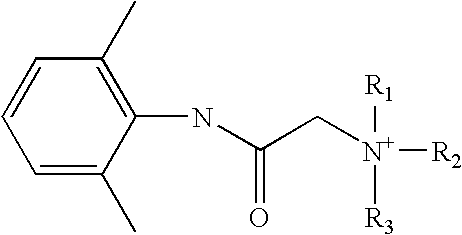Preparation of a quaternary ammonium hydroxide and use thereof for the preparation of a quaternary ammonium salt
a technology of quaternary ammonium hydroxide and ammonium salt, which is applied in the preparation of organic compounds, carboxylic acid amides, organic chemistry, etc., can solve the problem that every working step involving these compounds requires costly precautions
- Summary
- Abstract
- Description
- Claims
- Application Information
AI Technical Summary
Benefits of technology
Problems solved by technology
Method used
Image
Examples
example 1
Preparation of N-{2-[(2,6-dimethylphenyl)-amino]-2-oxoethyl}-N,N-diethyl-benzenemethanaminium hydroxide (denatonium hydroxide)
[0021]250 gram (1.07 mol) of 2-(diethylamino)-N-(2,6-dimethylphenyl)acetamide (Lignocaine) was added to 600 ml of water at 30-35° C. It was then slowly heated to 70-90° C., followed by the addition of 175.4 gram (1.39 mol) benzyl chloride at 70-90° C. The temperature was maintained at 70-90° C. for 20-24 hours while monitoring the reaction by thin layer chromatography for every 4 hours, until the remaining unreacted Lignocaine was less than 10%. The reaction mass was then cooled to 35-40° C. The aqueous reaction solution was extracted with 100 ml of toluene (twice) at 35-40° C. Approximately 920 gram of aqueous denatonium chloride solution was obtained. The assay was 50.7% as measured by titrimetry.
[0022]50% sodium hydroxide solution (129.3 gram sodium hydroxide in 129.3 ml water) was added hereto, i.e. 1.25 mol sodium hydroxide, against 1 mol denatonium chlo...
example 2
Preparation of N-{2-[(2,6-dimethylphenyl)-amino]-2-oxoethyl}-N,N-diethyl-benzenemethanaminium hydroxide (denatonium hydroxide) from N-chloroacetyl-2,6-dimethylaniline
[0024]1000 gram (5.06 mol) of N-chloroacetyl-2,6-dimethylaniline was added to 3250 ml water at 30-35° C. 280 gram of sodium carbonate and 550 gram (7.52 mol) of diethylamine was added hereto at 30-35° C. and the mixture was stirred for 2 hrs. It was then slowly heated to 60-62° C. and stirred for another 2 hrs at the same temperature. The temperature was raised to 70-90° C. and the mixture was stirred for 8 hrs at the same temperature. Then slowly 834 gram (6.59 mol) of benzyl chloride was added at 70-90° C. The temperature was maintained for 20-24 hrs at 70-90° C. while monitoring the reaction by thin layer chromatography for every 4 hrs, until the unreacted lignocaine was less than 10%. The reaction mass was cooled to 35-40° C. The aqueous reaction solution was extracted with 250 ml of toluene [twice] at 35-40° C. and...
example 3
Preparation of Preparation of Pure Quaternary Salts from Pure Quaternary Hydroxide
[0027]100 gram (0.29 mol) of denatonium hydroxide was added to 150 ml of acetone at 30-35° C. A solution of 38.91 gram (0.319 mol) of benzoic acid in 150 ml of acetone was added at 30-35° C., i.e. 1.1 mol benzoic acid against 1 mol denatonium hydroxide, and the thus obtained mixture was stirred for 30 min. at this temperature and 2.0 hrs at 30-35° C. Then the reaction mass was cooled to 18-22° C. and stirred for another 30 minutes, the solid filtered and subsequently washed with 25 ml acetone. 105 gram of denatonium benzoate was obtained on drying, yield was 80.52%. The quality met the USP specifications.
PUM
| Property | Measurement | Unit |
|---|---|---|
| melting point | aaaaa | aaaaa |
| melting point | aaaaa | aaaaa |
| temperatures | aaaaa | aaaaa |
Abstract
Description
Claims
Application Information
 Login to View More
Login to View More - R&D
- Intellectual Property
- Life Sciences
- Materials
- Tech Scout
- Unparalleled Data Quality
- Higher Quality Content
- 60% Fewer Hallucinations
Browse by: Latest US Patents, China's latest patents, Technical Efficacy Thesaurus, Application Domain, Technology Topic, Popular Technical Reports.
© 2025 PatSnap. All rights reserved.Legal|Privacy policy|Modern Slavery Act Transparency Statement|Sitemap|About US| Contact US: help@patsnap.com



